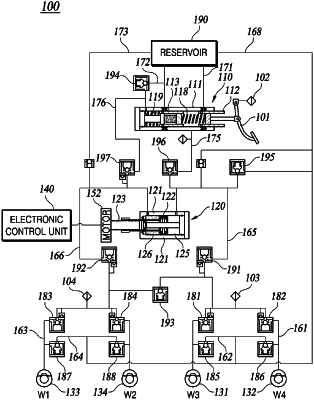| CPC B60T 8/176 (2013.01) [B60T 8/326 (2013.01); B60T 13/686 (2013.01); B60T 13/745 (2013.01); B60T 17/04 (2013.01); B60T 17/221 (2013.01); B60T 2220/04 (2013.01); B60T 2270/10 (2013.01); B60T 2270/402 (2013.01); B60T 2270/404 (2013.01); B60T 2270/82 (2013.01); B60T 2270/88 (2013.01)] | 8 Claims |

|
1. A braking device for a vehicle including a reservoir, a wheel brake apparatus, a back-up master cylinder, a main master cylinder, and a motor, the braking device comprising:
a main line configured to transmit a hydraulic pressure between the main master cylinder and the wheel brake apparatus;
a traction control valve, which is configured to be a normally open valve in absence of current being applied thereto, disposed on the main line and configured to control opening and closing of the main line; and
an electronic control unit configured to control the motor and the traction control valve and calculate a required pressure for braking the vehicle and for the hydraulic pressure in the main line,
wherein the electronic control unit is configured to:
increase the hydraulic pressure in the main line by applying a first current to the motor when the required pressure for braking the vehicle is greater than the hydraulic pressure in the main line; and
decrease the hydraulic pressure in the main line by applying a second current to the motor, different from the first current, and opening the traction control valve in absence of application of current thereto when the required pressure for braking the vehicle is lower than or equal to the hydraulic pressure in the main line,
wherein:
the main line includes a first main line and a second main line,
the traction control valve includes:
a first traction control valve disposed on the first main line; and
a second traction control valve disposed on the second main line and configured to control opening and closing of the second main line,
the main master cylinder includes a main piston configured to divide an inner space of the main master cylinder into a first main chamber and a second main chamber,
when the motor moves the main piston in a forward direction, the first main chamber becomes narrower and the second main chamber becomes wider,
when the motor moves the main piston in a rearward direction, the first main chamber becomes wider and the second main chamber becomes narrower,
the electronic control unit is further configured to control the motor to perform:
a low pressure increase process including decreasing a volume of the first main chamber and increasing the hydraulic pressure in the main line; and
a high pressure increase process including increasing the volume of the first main chamber and the hydraulic pressure in the main line; and
the electronic control unit is further configured to:
determine whether the hydraulic pressure in the main line is increasing at a time when the required pressure for braking the vehicle is lower than or equal to the hydraulic pressure in the main line;
in response to determining that the hydraulic pressure in the main line is increasing at a time when the motor performs the low pressure increase process, open the first traction control valve;
in response to determining that the hydraulic pressure in the main line is increasing at a time when the motor performs the high pressure increase process, open the second traction control valve; and
in response to determining that the hydraulic pressure in the main line is not increasing, maintain the first and second traction control valves closed.
|